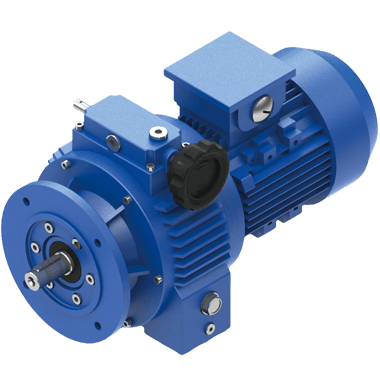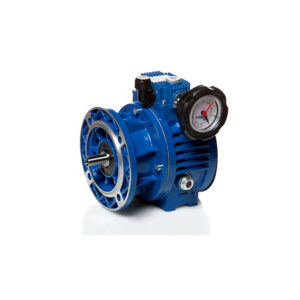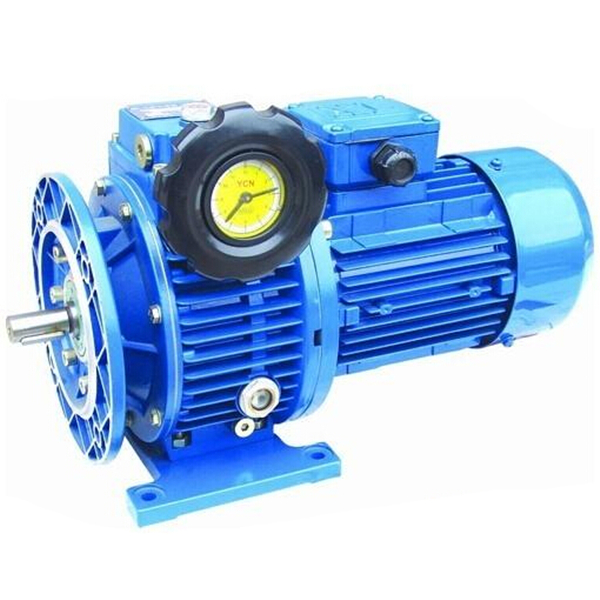Product Description
Product Description
Product Characteristics:
1.High speed-regulating precision :0.5-1 rotation
2.High speed-changing range: ratio from 1:1.4 to 1:7 freely;
3.High strength and long service life
4.Convenient to regulate speed
5.Can run continuously, front to back running direction, smooth running,stable performance, and low noise.
6.Sealed fully and suitable for any environment
7.Companct structure and small volume
8.Made of high quality aluminium alloy diecast into foarming, nice appearance,light weight and non-rusty.9.Good adaptation:UDL series speed variators can be combined with all kinds of speed reducers to achive low stepless speed regulating(such as R-K-F-S Series and NMRV worm reducers).
Applications:
UDL series stepless speed variators are widely used for foodstaffs, packing, chemicals,pharmacy,plastics, paper-making, machine tools,communications and all kinds of automatic lines,pipelines and assembly lines which need speed regulating. It is a good companion for production machines.
Detailed Photos
Product Parameters
| PERFORMANCE PARAMETER | ||||
| Performance table for UDL series speed variators(n1=1400r/min) | ||||
| Motor Power | Model | i | n2(r/min) | M2(Nm) |
| 0.18KW | UDL002(UDL0.18) | 1.6∽8.2 | 880∽170 | 1.5∽3 |
| 0.37KW | UDL005(UDL0.37) | 1.4∽7 | 1000∽200 | 3∽6 |
| 0.75KW | UDL571(UDL0.75) | 1.4∽7 | 1000∽200 | 6∽12 |
| 1.5KW | UD571(UD1.5) | 1.4∽7 | 1000∽200 | 12∽24 |
| 2.2KW | UD030(UD2.2) | 1.4∽7 | 1000∽200 | 18∽36 |
| 3.0KW | UD040(UD3.0) | 1.4∽7 | 1000∽200 | 24∽48 |
| 4.0KW | UD050(UD4.0) | 1.4∽7 | 1000∽200 | 32∽64 |
Outline Dimension:
Company Profile
About our company:
We are a professional reducer manufacturer located in HangZhou, ZHangZhoug province.Our leading products is full range of RV571-150 worm reducers , also supplied hypoid helical gearbox, PC units, UDL Variators and AC Motors.Products are widely used for applications such as: foodstuffs, ceramics, packing, chemicals, pharmacy, plastics, paper-making, construction machinery, metallurgic mine, environmental protection engineering, and all kinds of automatic lines, and assembly lines.With fast delivery, superior after-sales service, advanced producing facility, our products sell well both at home and abroad. We have exported our reducers to Southeast Asia, Eastern Europe and the Middle East and so on.Our aim is to develop and innovate on the basis of high quality, and create a good reputation for reducers.
Workshop:
Exhibition:
We participate Germany Hannver Exhibition-ZheJiang PTC Fair-Turkey Win Eurasia
Packaging & Shipping
Packing information:Plastic Bags+Cartons+Wooden Cases , or on request.
Installation Instructions
To install the reducer, it is necessary to note the following issues:
1)Check the correct rotation direction of output shaft before fitting reducer to machines.
2)Before mounting, pls check shaft diameter, bore diameter, key and keyway, to be sure their dimension are not deviation; In order to keep good performance, also pls avoid assembling too tight or too loose.
3)Reducer must be mounted to machines stably to avoid vibration.
4)Whenever possible,protect the reducer against solar radiation and bad weather.
5)In the case of particularly lengthy period of storage(4-6 months), if the oil seal is not immersed in lubricant inside the unit, it is recommended to change it since the rubber could stick to the shaft or may even have lost the elasticity.
6)Painting must definitely not go over rubber parts and the holes on breather plug if any.
7)When connect with hollow or CHINAMFG shaft, pls grease the joint to avoid lock or oxidation.
8)Check the correct lubricant level through indicator if there is one.
9)Starting must take place gradually, without immediately applying the maximum load.
10)When using various of motors to match reducer directly, supporting unit is required if motor is too heavy.
11)Ensure good heat dissipation by keeping good ventilation near the motor fan.
12)In the case of ambient temperature40ºC, pls call the technical department.
After Sales Service
1.Maintenance Time and Warranty:Within 1 year after receiving goods.
2.Other Service: Including modeling selection guide, installation guide, and problem resolution guide, etc.
FAQ
1.Q:Can you make as per customer drawing?
A: Yes, we offer customized service for customers accordingly. We can use customer’s nameplate for gearboxes.
2.Q:What is your terms of payment ?
A: 30% deposit before production,balance T/T before delivery.
3.Q:Are you a trading company or manufacturer?
A:We are a manufacurer with advanced equipment and experienced workers.
4.Q:What’s your production capacity?
A:8000-9000 PCS/MONTH
5.Q:Free sample is available or not?
A:Yes, we can supply free sample if customer agree to pay for the courier cost
6.Q:Do you have any certificate?
A:Yes, we have CE certificate and SGS certificate report.
Contact information:
Ms Lingel Pan
For any questions just feel free ton contact me. Many thanks for your kind attention to our company!
| Application: | Motor, Machinery, Marine, Agricultural Machinery, Industry |
|---|---|
| Hardness: | Hardened Tooth Surface |
| Installation: | Vertical or Horizontal Type |
| Layout: | Coaxial |
| Gear Shape: | Planetary Gear |
| Step: | Stepless |
| Samples: |
US$ 15/Piece
1 Piece(Min.Order) | |
|---|
| Customization: |
Available
|
|
|---|

What factors should be considered when selecting a variator for different industrial applications?
When selecting a variator for different industrial applications, several factors need to be considered to ensure optimal performance and compatibility. Here are the key factors that should be taken into account:
1. Load Requirements:
The first factor to consider is the load requirements of the specific industrial application. Determine the torque and power demands of the machinery or equipment that the variator will be driving. It is essential to select a variator that can handle the anticipated load conditions without exceeding its maximum torque or power capabilities. Consider factors such as starting torque, peak torque, and continuous torque requirements to ensure the variator can handle the load effectively.
2. Speed Range:
Consider the required speed range for the application. Determine the minimum and maximum speeds that the variator needs to achieve. Variators are designed to operate within specific speed ranges, so it is crucial to select a model that can accommodate the required speed range while maintaining optimal performance. Additionally, consider the desired speed resolution or increments required for precise speed control.
3. Environmental Conditions:
Take into account the environmental conditions in which the variator will operate. Factors such as temperature, humidity, dust, and vibration levels can impact the performance and longevity of the variator. Choose a variator that is designed to withstand the specific environmental conditions of the industrial application. For example, some variators are specifically designed for harsh or hazardous environments and have enhanced protection against dust, moisture, or extreme temperatures.
4. Control System Integration:
Determine how the variator will integrate with the control system of the industrial application. Consider compatibility with existing control interfaces or protocols, such as analog, digital, or fieldbus systems. Ensure that the variator can be easily integrated into the control architecture of the machinery or equipment, allowing for seamless communication and control. Compatibility with programmable logic controllers (PLCs) or other control devices should also be evaluated.
5. Operational Efficiency:
Evaluate the operational efficiency of the variator. Look for features that contribute to energy efficiency, such as low power losses or regenerative capabilities. A variator that operates efficiently can help reduce energy consumption, lower operating costs, and minimize the environmental impact. Consider features like automatic energy optimization, energy monitoring, or sleep modes that can enhance the overall efficiency of the variator.
6. Maintenance and Serviceability:
Consider the ease of maintenance and serviceability of the variator. Look for features that simplify maintenance tasks, such as accessible components, user-friendly interfaces, and diagnostic capabilities. Additionally, consider the availability of spare parts and the reputation of the manufacturer or supplier in terms of customer support and after-sales service.
7. Cost and Budget:
Finally, evaluate the cost of the variator and its alignment with the budget for the industrial application. Consider the initial purchase cost as well as the long-term operational costs, including energy consumption, maintenance, and potential downtime. It is important to strike a balance between the desired features, performance, and cost-effectiveness to ensure the best value for the specific application.
By considering these factors – load requirements, speed range, environmental conditions, control system integration, operational efficiency, maintenance and serviceability, and cost – when selecting a variator for different industrial applications, you can make an informed decision that meets the specific needs of the machinery or equipment, ensuring reliable and efficient operation.

How do electronic or computer-controlled variators improve performance and efficiency?
Electronic or computer-controlled variators, such as electronically controlled continuously variable transmissions (eCVTs), play a crucial role in improving the performance and efficiency of vehicles. These advanced variators utilize electronic control systems to optimize power delivery, adapt to driving conditions, and enhance overall drivetrain efficiency. Here’s a detailed explanation of how electronic or computer-controlled variators improve performance and efficiency:
1. Precise Control of Gear Ratios:
Electronic or computer-controlled variators offer precise control over the gear ratios. The electronic control systems continuously monitor various parameters such as vehicle speed, engine load, throttle input, and road conditions. Based on this information, the control system adjusts the gear ratios in real-time to ensure optimal power delivery. This precise control allows the engine to operate within its most efficient range, maximizing performance and improving fuel efficiency.
2. Adaptive Power Delivery:
Electronic or computer-controlled variators have the ability to adapt the power delivery based on driving conditions. The control system can analyze various factors, including vehicle speed, acceleration, and driver input, and adjust the gear ratios accordingly. For example, during highway cruising, the variator can keep the engine at lower RPMs to achieve better fuel efficiency. In contrast, during quick acceleration or overtaking, the variator can provide maximum power by adjusting the gear ratios for optimal performance. This adaptive power delivery enhances both performance and efficiency.
3. Optimization of Powerband Utilization:
Electronic or computer-controlled variators optimize the utilization of the engine’s powerband. The control system continuously adjusts the gear ratios to keep the engine operating within its optimal RPM range, where it generates the highest torque and power. By utilizing the engine’s powerband effectively, the variator ensures that the engine operates efficiently in a wide range of driving conditions. This optimization results in improved drivability, responsive acceleration, and better overall performance.
4. Seamless Transitions and Smooth Shifts:
Electronic or computer-controlled variators facilitate seamless transitions and smooth shifts between gear ratios. The control system ensures that gear changes are executed rapidly and with minimal interruption in power delivery. Unlike traditional transmissions with fixed gear steps, electronic variators can adjust the gear ratios continuously and steplessly. This eliminates the noticeable gear shifts and associated power interruptions, resulting in a smoother and more comfortable driving experience.
5. Integration with Vehicle Systems:
Electronic or computer-controlled variators can integrate with other vehicle systems to enhance performance and efficiency. They can communicate with the engine management system, traction control system, and other electronic control units to optimize the overall drivetrain operation. For example, the variator can work in conjunction with the engine management system to adjust the engine’s operating parameters based on the desired power delivery. This integration ensures coordinated and efficient operation of various vehicle systems, ultimately improving overall performance and efficiency.
6. Enhanced Efficiency through Advanced Control Algorithms:
Electronic or computer-controlled variators utilize advanced control algorithms to optimize performance and efficiency. These algorithms take into account multiple inputs, such as vehicle speed, engine load, temperature, and driver behavior, to make intelligent decisions regarding gear ratio adjustments. The control system can continuously learn and adapt to individual driving styles, further improving efficiency over time. The use of advanced control algorithms allows electronic variators to achieve higher levels of efficiency compared to traditional mechanical transmissions.
7. Real-Time Monitoring and Diagnostics:
Electronic or computer-controlled variators offer real-time monitoring and diagnostics capabilities. The control system can monitor the health and performance of various components within the variator, as well as detect any abnormalities or potential issues. This allows for proactive maintenance and timely repairs, ensuring optimal performance and reliability. Real-time monitoring and diagnostics contribute to the overall efficiency and longevity of the variator.
In conclusion, electronic or computer-controlled variators improve performance and efficiency through precise control of gear ratios, adaptive power delivery, optimization of powerband utilization, seamless transitions, integration with vehicle systems, advanced control algorithms, and real-time monitoring and diagnostics. These advanced variators optimize power delivery, enhance drivetrain efficiency, and provide a smoother, more responsive driving experience, ultimately improving both performance and fuel efficiency.

How does a variator differ from traditional gear systems in vehicles?
A variator differs from traditional gear systems in vehicles in several ways. While traditional gear systems use discrete gears to provide specific gear ratios, a variator offers a continuously variable transmission (CVT) that can provide an infinite number of gear ratios within a specific range. Here’s a detailed explanation of how a variator differs from traditional gear systems:
Gear Ratio Variation:
In traditional gear systems, gear ratios are fixed and discrete. Vehicles with manual or automatic transmissions have a predetermined set of gears that are engaged based on the desired speed and load conditions. Each gear provides a specific ratio between the input (engine) and output (wheels) shafts. The gear changes occur through mechanical shifting or electronically controlled mechanisms.
In contrast, a variator in a CVT offers continuous gear ratio variation. Instead of discrete gears, a variator uses adjustable pulleys or other mechanisms to change the effective diameter or contact ratio between the driving and driven elements. This allows for seamless and continuous adjustment of the gear ratio, providing a smooth and efficient power transfer.
Stepless Gear Shifts:
In traditional gear systems, gear shifts occur in steps as the transmission shifts from one gear to another. Each gear ratio change results in a noticeable shift in engine RPM and vehicle acceleration. These stepped gear shifts can sometimes cause a jolt or interruption in power delivery.
On the other hand, a variator in a CVT allows for stepless gear shifts. Since the gear ratio can be continuously adjusted, there are no discrete steps between gears. This results in a smooth and seamless transition between gear ratios, without any noticeable gear shifts or jolts. The engine RPM can also be held at an optimal level for improved fuel efficiency and performance.
Optimized Engine RPM:
In traditional gear systems, the engine RPM typically varies with each gear change. The engine operates at higher RPMs during acceleration and lower RPMs during cruising to match the gear ratios.
A variator in a CVT enables the engine to operate at its optimal RPM for a given driving condition. By continuously varying the gear ratio, the engine can maintain a consistent RPM, optimizing fuel efficiency and power delivery. This allows the engine to operate within its most efficient power band, resulting in improved fuel economy.
Flexibility and Efficiency:
Traditional gear systems have a limited number of gears, which can sometimes result in less flexibility in finding the ideal gear ratio for a specific driving condition. This can lead to compromises in terms of performance or fuel efficiency.
A variator in a CVT offers greater flexibility and efficiency. It can continuously adjust the gear ratio to match the specific demands of the driver and driving conditions. This allows for improved performance, smoother acceleration, and better fuel economy by keeping the engine within its optimal operating range.
In summary, a variator in a CVT differs from traditional gear systems in vehicles by offering continuous gear ratio variation, stepless gear shifts, optimized engine RPM, and increased flexibility and efficiency. These differences contribute to a smoother driving experience, improved fuel economy, and optimized power delivery in various driving conditions.


editor by CX 2023-12-15